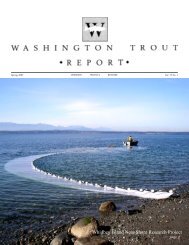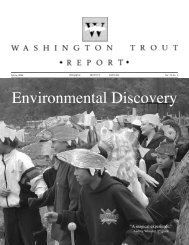Seafood Watch
Pacific Salmon - Wild Fish Conservancy
Pacific Salmon - Wild Fish Conservancy
- No tags were found...
You also want an ePaper? Increase the reach of your titles
YUMPU automatically turns print PDFs into web optimized ePapers that Google loves.
<strong>Seafood</strong> <strong>Watch</strong>® Wild Pacific Salmon Report October 8, 2010<br />
Commercial Coho Salmon Landings (1950-2002)<br />
35,000.00<br />
30,000.00<br />
metric tons<br />
25,000.00<br />
20,000.00<br />
15,000.00<br />
10,000.00<br />
Alaska<br />
California<br />
Oregon<br />
Washington<br />
6 year avg (AK)<br />
6 year avg (WA)<br />
6 year avg (OR)<br />
5,000.00<br />
0.00<br />
1940 1950 1960 1970 1980 1990 2000 2010<br />
Figure 2.9. Commercial landings of Alaskan coho salmon (NMFS 2004b).<br />
Alaskan Chinook Salmon<br />
Chinook salmon make up the smallest portion of Alaska’s salmon harvest. In 2003, roughly 10<br />
million pounds of Chinook salmon were landed, comprising just over 1% of the state salmon<br />
harvest (Plotnick and Eggers 2004). In contrast to the other four salmon species, landings of<br />
Chinook salmon in Alaska have shown a downward trend over the past fifty years (Figure 2.10).<br />
Two-thirds of Alaska’s 2003 landings came from Southeast Alaska (418,000 fish), with the<br />
remainder split between a number of other regions including Prince William Sound (48,000<br />
fish), Bristol Bay (44,000 fish), and the Arctic-Yukon-Kuskokwim Region (57,000 fish)<br />
(Plotnick and Eggers 2004). The Southeast Alaska harvest of 418,000 fish was the largest on<br />
record since 1953. Chinook salmon are also remarkable in that they are the only salmon species<br />
in Alaska for which a significant quantity (roughly half) are landed with troll gear. Notably, the<br />
Southeast Alaska troll fishery recorded the 4 th highest landings of Chinook salmon since Alaskan<br />
statehood. Hatchery fish are estimated to have contributed just 7% to troll landings. Chinook<br />
escapement within Southeast Alaska fell between 2002 and 2003, but remained within<br />
management goals for all but two rivers. Prince William Sound Chinook landings were the 7 th<br />
largest on record in 2003, while escapement remained within management targets. Bristol Bay<br />
landings of Chinook salmon were lower than average in 2003, while escapement was just<br />
slightly above the target level (Plotnick and Eggers 2004).<br />
Overall, the trend in landings of Chinook salmon in Alaska appears to be relatively flat or<br />
slightly downward. It is possible that reduced fishing pressure following falling salmon prices<br />
over the past decade has contributed to this reduced harvest. In any case, recent record harvests<br />
and escapement levels within management targets generally indicate a healthy stock status.<br />
49






